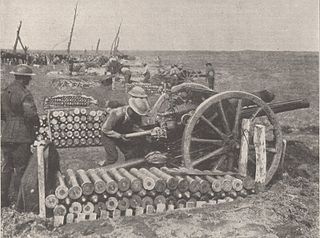
The Ordnance QF 18-pounder, or simply 18-pounder gun, was the standard British Empire field gun of the First World War-era. It formed the backbone of the Royal Field Artillery during the war, and was produced in large numbers. It was used by British Forces in all the main theatres, and by British troops in Russia in 1919. Its calibre (84 mm) and shell weight were greater than those of the equivalent field guns in French (75 mm) and German (77 mm) service. It was generally horse drawn until mechanisation in the 1930s.

The Ordnance BL 60-pounder was a British 5 inch (127 mm) heavy field gun designed in 1903–05 to provide a new capability that had been partially met by the interim QF 4.7 inch Gun. It was designed for both horse draft and mechanical traction and served throughout the First World War in the main theatres. It remained in service with British and Commonwealth forces in the inter-war period and in frontline service with British and South African batteries until 1942 being superseded by the BL 4.5 inch Medium Gun.
This article explains terms used for the British Armed Forces' ordnance (weapons) and ammunition. The terms may have different meanings depending on its usage in another country's military.

The Ordnance QF 13-pounder (quick-firing) field gun was the standard equipment of the British and Canadian Royal Horse Artillery at the outbreak of World War I.

The BL 8-inch howitzer Mark I through to Mark V were a British improvisation developed early in the First World War to provide heavy artillery. It used shortened and bored-out barrels from various redundant naval 6-inch guns.

The 13 pounder 9 cwt anti-aircraft gun became the standard mobile British anti-aircraft gun of the World War I era, especially in theatres outside Britain.
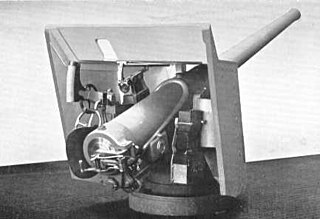
The QF 4.7-inch Gun Mks I, II, III, and IV were a family of British quick-firing 4.724-inch (120 mm) naval and coast defence guns of the late 1880s and 1890s that served with the navies of various countries. They were also mounted on various wheeled carriages to provide the British Army with a long range gun. They all had a barrel of 40 calibres length.

The Ordnance BLC 15-pounder gun was a modernised version of the obsolete BL 15-pounder 7 cwt gun, incorporating a recoil and recuperator mechanism above the barrel and a modified quicker-opening breech. It was developed to provide Territorial Force artillery brigades with a reasonably modern field gun without incurring the expense of equipping them with the newer 18-pounder. It is the gun that writers usually mean by "15-pounder gun" in World War I, but can be confused with the earlier Ordnance QF 15-pounder Ehrhardt or Ordnance BL 15-pounder, both of which fired the same shell.

The British Ordnance BL 12 inch howitzer on truck, railway, a type of railway gun, was developed following the success of the 9.2-inch siege howitzer. It was similar but unrelated to the 12-inch siege howitzers Mk II and IV.

The British Ordnance BL 9.2 inch gun on truck, railway mounted a variety of surplus 9.2 inch naval guns, together with the custom-designed Mk XIII railway gun, on various railway platforms to provide mobile long-range heavy artillery on the Western Front in World War I. Mk XIII remained in service for British home defence in World War II.

The QF 3-inch 20 cwt anti-aircraft gun became the standard anti-aircraft gun used in the home defence of the United Kingdom against German Zeppelins airships and bombers and on the Western Front in World War I. It was also common on British warships in World War I and submarines in World War II. 20 cwt referred to the weight of the barrel and breech, to differentiate it from other 3-inch guns. While other AA guns also had a bore of 3 inches (76 mm), the term 3-inch was only ever used to identify this gun in the World War I era, and hence this is what writers are usually referring to by 3-inch AA gun.
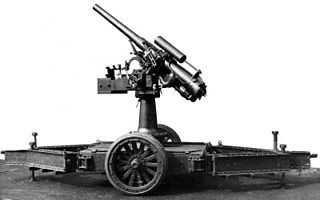
The 12 pounder 12 cwt anti-aircraft gun was borrowed for AA use from the QF 12 pounder 12 cwt coast defence gun with the addition of a modified cradle for higher elevation, a retaining catch for the cartridge, and an additional spring recuperator above the barrel and high-angle sights. Writers commonly refer to it simply as "12 pounder anti-aircraft gun". 12 cwt referred to the weight of the barrel and breech [12 × 112 lb (51 kg) = 1,344 lb (610 kg)] to differentiate it from other 12-pounder guns.

The Ordnance QF 13 pounder Mk III anti-aircraft gun, also known as 13 pounder 6 cwt, was an early British improvisation in World War I to adapt the QF 13-pounder field gun to anti-aircraft use. 6 cwt referred to the weight of barrel and breech to differentiate it from other "13 pounder" guns.

The QF 6-inch 40 calibre naval gun (Quick-Firing) was used by many United Kingdom-built warships around the end of the 19th century and the start of the 20th century.
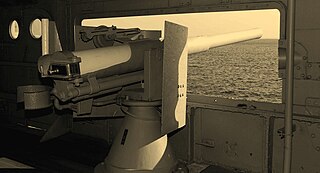
The QF 12-pounder 12-cwt gun (Quick-Firing) was a common, versatile 3-inch (76.2 mm) calibre naval gun introduced in 1894 and used until the middle of the 20th century. It was produced by Armstrong Whitworth, Elswick and used on Royal Navy warships, exported to allied countries, and used for land service. In British service "12-pounder" was the rounded value of the projectile weight, and "12 cwt (hundredweight)" was the weight of the barrel and breech, to differentiate it from other "12-pounder" guns.

The Ordnance QF Hotchkiss 6 pounder gun Mk I and Mk II or QF 6 pounder 8 cwt were a family of long-lived light 57 mm naval guns introduced in 1885 to defend against new, small and fast vessels such as torpedo boats and later submarines. There were many variants produced, often under license which ranged in length from 40 to 58 calibers, but 40 caliber was the most common version.

The Ordnance QF 6-pounder 6 cwt Hotchkiss Mk I and Mk II was a shortened version of the original QF 6 pounder Hotchkiss naval gun, and was developed specifically for use in the sponsons of the later marks of British tanks in World War I, from Mark IV onwards.

The QF 4 inch Mk V gun was a Royal Navy gun of World War I which was adapted on HA mountings to the heavy anti-aircraft role both at sea and on land, and was also used as a coast defence gun.

The BL 6-inch gun Marks II, III, IV and VI were the second and subsequent generations of British 6-inch rifled breechloading naval guns, designed by the Royal Gun Factory in the 1880s following the first 6-inch breechloader, the relatively unsuccessful BL 6-inch 80-pounder gun designed by Elswick Ordnance. They were originally designed to use the old gunpowder propellants but from the mid-1890s onwards were adapted to use the new cordite propellant. They were superseded on new warships by the QF 6-inch gun from 1891.
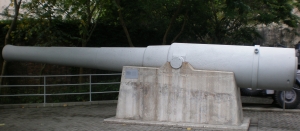
The BL 10 inch guns Mks I, II, III, IV were British rifled breechloading 32-calibre naval and coast defence guns in service from 1885.


















